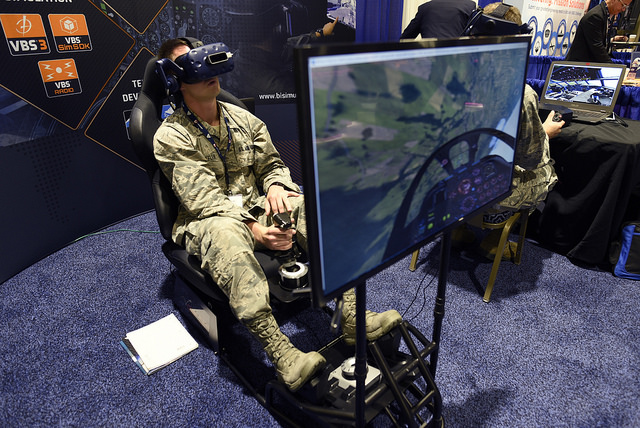
Cadet Jacob Lefler, USAF ROTC Det. 800, University of Tennessee, tries an advanced training simulator at the Bohemia Interactive booth at the Tech Expo at the Air Force Association's Air, Space & Cyber Conference at the Gaylord National Convention Center, National Harbor, Md. Staff photo by Mike Tsukamoto.
Air Education and Training Command is conducting beta tests and studying to better understand how the human brain works in order to take advantage of artificial intelligence to help students gain a deeper knowledge of their jobs much faster than they would under traditional teaching methods.
AETC boss Lt. Gen. Steven Kwast said he is not yet ready to say exactly how AI can be incorporated into the curriculum, but said the command will present its findings to the Secretary of the Air Force next summer. So far, the data is promising. “We can accentuate the adult human brain to learn faster, better, and … when you learn something, you remember it longer,” Kwast told reporters. “The data is clearly showing there is some potential there.”
Two training squadrons at JBSA-Randolph, Texas, have launched an experimental program to use commercially available virtual reality technology to help train instructor pilots more economically and effectively.
The Pilot Instructor Next program, initiated in May by the 99th and 560th Flying Training Squadrons, uses a combination of virtual-reality goggles and simulators to supplement flying time for new T-1 and T-38 instructor pilots.
Using technology priced from as little as $250 to a few thousand dollars, the Air Force can now deliver capabilities “very close” to conventional simulators priced in the millions, said Lt. Col. Justin Chandler, commander of the 99th.
The affordable technology enables the Air Force “to create a 3-D environment” that allows “human beings to feel like they are in the moment,” said Kwast. “We’re finding that makes the brain learn better and faster, so when they actually do the real event they are learning more deeply.”
Air Education and Training Command also is using artificial intelligence coaches in training. The AI coach is always there, watching what students are doing, how they learn, and offering real-time advice to help them do things better. For example, if a student pilot needs to fly a loop, the AI coach will know if they are pulling too hard on the stick and can tell them to ease up; or it can sense if the nose of the aircraft is veering to the right, cautioning students to keep their eyes on the horizon, said Kwast.
The AI coach learns what helps the student learn best, personalizing the training. If he or she is a visual learner and needs to see how something is accomplished before doing it themselves; if the student learns better reading about the task first, it can align the training that way.
“It’s not the blind leading the blind. It’s an artificial intelligence that’s actually adapting the environment in which you learn, and it’s coaching you along the way so you’re reminded of what you’re doing right and what you’re doing wrong,” Kwast said. “These are the things the artificial intelligence is helping us with.”
Lt. Col. Matt Strohmeyer, commander of the 560th, said the pilot shortage has forced the Air Force to sometimes use mobility pilots as T-38 instructors, rather than fighter pilots only, and that the new technology helps get them up to speed faster. Using the low-cost simulations, instructors can become familiar with the T-1 or T-38 before they fly them for real. “It allows them to just see and experience what it’s like to be able to do that,” he said.
The low cost means the squadrons can afford to have many more systems, and the 24/7 availability means students can get as much time as they need doing repetitions, which wasn’t possible before.
Where previous graduates would have experienced various critical tasks, such as flying an overhead traffic pattern, only about 15 or 20 times, now they can experience that “hundreds of times” without additional expense.
Pilot Instructor Next, which now has about 30 students, follows another AETC program, the Pilot Training Next program, which began in January and last month graduated its first 13 officers. Strohmeyer said the instructor program graduated its first student about two weeks ago and another three are expected to graduate in coming weeks.
“This is really Learning Next,” said Kwast. “It’s the art of innovation, where you let people have the freedom, and the money, and the authority to try and tinker like Wright brothers did in the bicycle shop to see what’s in the realm of the possible without being anchored to the past.”